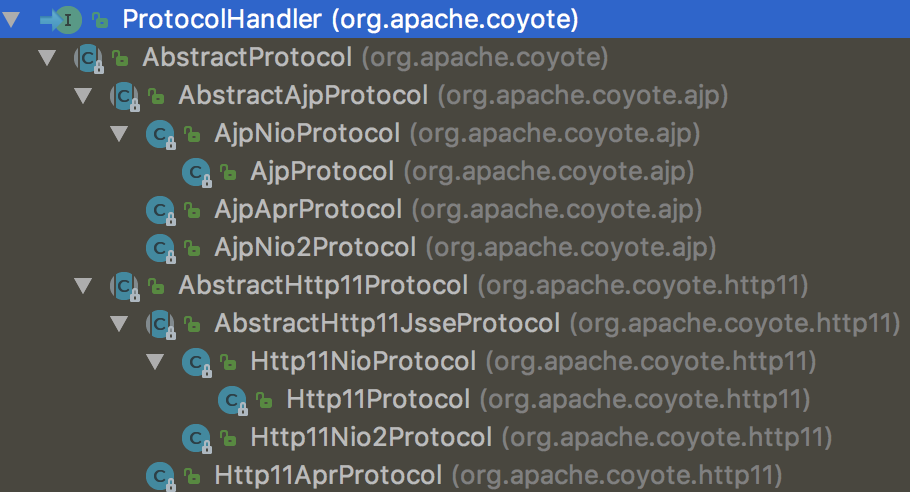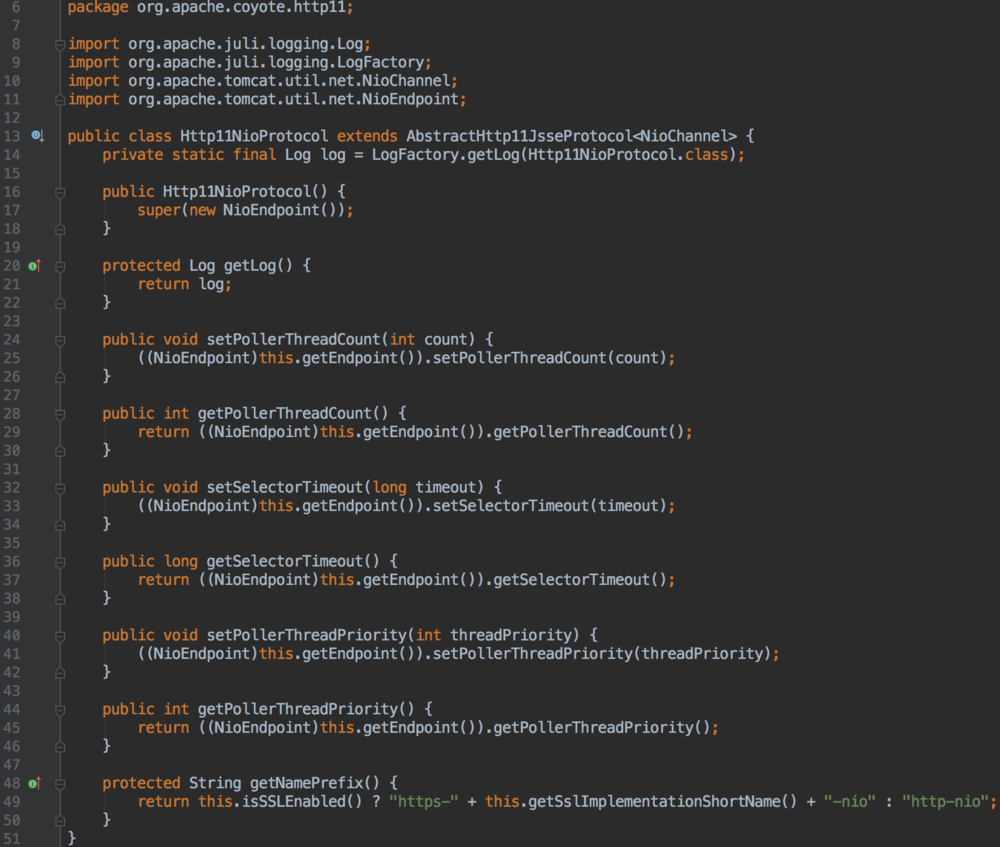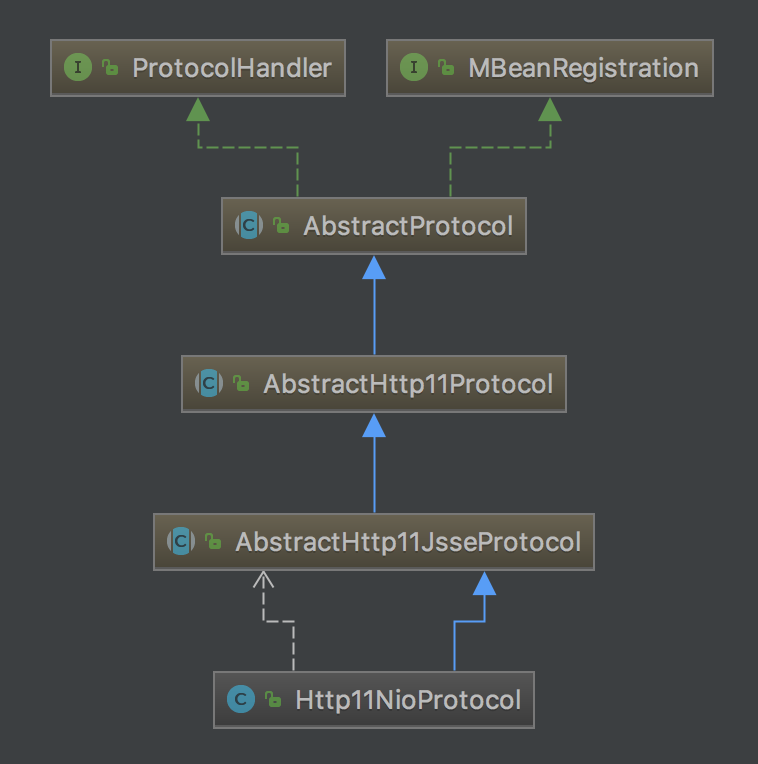上文简单记录了默认的Connector的内部构造及消息流,同时此Connector也是基于BIO的实现。
除BIO,也可以通过配置快速部署NIO的connector。在server.xml中如下配置;

整个Tomcat是一个比较完善的框架体系,各组件间都是基于接口实现,方便扩展
像这里的org.apache.coyote.http11.Http11NioProtocol和BIO的org.apache.coyote.http11.Http11Protocol都是统一的实现org.apache.coyote.ProtocolHandler接口

ProtocolHandler的实现类
从整体结构上来说,NIO还是与BIO的实现保持大体一致

NIO connector的内部结构
还是可以看见Connector中三大件
Http11NioProtocol
Mapper
CoyoteAdapter
基本功能与BIO的类似
重点看看Http11NioProtocol.


和JIoEndpoint一样,NioEndpoint是Http11NioProtocol中负责接收处理socket的主要模块

NioEndpoint的主要流程
Acceptor及Worker分别是以线程池形式存在
Poller是一个单线程
注意,与BIO的实现一样,默认状态下,在server.xml中
没有配置<Executor>,则以Worker线程池运行
配置了<Executor>,则以基于juc 系列的ThreadPoolExecutor线程池运行。
Acceptor
接收socket线程,这里虽然是基于NIO的connector,但是在接收socket方面还是传统的serverSocket.accept()方式,获得SocketChannel对象
然后封装在一个tomcat的实现类
org.apache.tomcat.util.net.NioChannel对象中然后将NioChannel对象封装在一个PollerEvent对象中,并将PollerEvent对象压入events queue里。这里是个典型的生产者-消费者模式,Acceptor与Poller线程之间通过queue通信,Acceptor是events queue的生产者,Poller是events queue的消费者。
Poller
Poller线程中维护了一个Selector对象,NIO就是基于Selector来完成逻辑的
在Connector中并不止一个Selector,在Socket的读写数据时,为了控制timeout也有一个Selector,在后面的BlockSelector中介绍。可以先把Poller线程中维护的这个Selector标为主Selector
Poller是NIO实现的主要线程。首先作为events queue的消费者,从queue中取出PollerEvent对象,然后将此对象中的channel以OP_READ事件注册到主Selector中,然后主Selector执行select操作,遍历出可以读数据的socket,并从Worker线程池中拿到可用的Worker线程,然后将socket传递给Worker。整个过程是典型的NIO实现。
Worker
Worker线程拿到Poller传过来的socket后,将socket封装在SocketProcessor对象中。然后从Http11ConnectionHandler中取出Http11NioProcessor对象,从Http11NioProcessor中调用CoyoteAdapter的逻辑,跟BIO实现一样。在Worker线程中,会完成从socket中读取http request,解析成HttpServletRequest对象,分派到相应的servlet并完成逻辑,然后将response通过socket发回client。在从socket中读数据和往socket中写数据的过程,并没有像典型的非阻塞的NIO的那样,注册OP_READ或OP_WRITE事件到主Selector,而是直接通过socket完成读写,这时是阻塞完成的,但是在timeout控制上,使用了NIO的Selector机制,但是这个Selector并不是Poller线程维护的主Selector,而是BlockPoller线程中维护的Selector,称之为辅Selector。
NioSelectorPool
NioEndpoint对象中维护了一个NioSelecPool对象,这个NioSelectorPool中又维护了一个BlockPoller线程,这个线程就是基于辅Selector进行NIO的逻辑。以执行servlet后,得到response,往socket中写数据为例,最终写的过程调用NioBlockingSelector的write方法。
public int write(ByteBuffer buf, NioChannel socket, long writeTimeout,MutableInteger lastWrite) throws IOException {
SelectionKey key = socket.getIOChannel().keyFor(socket.getPoller().getSelector());
if ( key == null ) throw new IOException("Key no longer registered");
KeyAttachment att = (KeyAttachment) key.attachment();
int written = 0;
boolean timedout = false;
int keycount = 1; //assume we can write
long time = System.currentTimeMillis(); //start the timeout timer
try {
while ( (!timedout) && buf.hasRemaining()) {
if (keycount > 0) { //only write if we were registered for a write
//直接往socket中写数据
int cnt = socket.write(buf); //write the data
lastWrite.set(cnt);
if (cnt == -1)
throw new EOFException();
written += cnt;
//写数据成功,直接进入下一次循环,继续写
if (cnt > 0) {
time = System.currentTimeMillis(); //reset our timeout timer
continue; //we successfully wrote, try again without a selector
}
}
//如果写数据返回值cnt等于0,通常是网络不稳定造成的写数据失败
try {
//开始一个倒数计数器
if ( att.getWriteLatch()==null || att.getWriteLatch().getCount()==0) att.startWriteLatch(1);
//将socket注册到辅Selector,这里poller就是BlockSelector线程
poller.add(att,SelectionKey.OP_WRITE);
//阻塞,直至超时时间唤醒,或者在还没有达到超时时间,在BlockSelector中唤醒
att.awaitWriteLatch(writeTimeout,TimeUnit.MILLISECONDS);
}catch (InterruptedException ignore) {
Thread.interrupted();
}
if ( att.getWriteLatch()!=null && att.getWriteLatch().getCount()> 0) {
keycount = 0;
}else {
//还没超时就唤醒,说明网络状态恢复,继续下一次循环,完成写socket
keycount = 1;
att.resetWriteLatch();
}
if (writeTimeout > 0 && (keycount == 0))
timedout = (System.currentTimeMillis() - time) >= writeTimeout;
} //while
if (timedout)
throw new SocketTimeoutException();
} finally {
poller.remove(att,SelectionKey.OP_WRITE);
if (timedout && key != null) {
poller.cancelKey(socket, key);
}
}
return written;
}也就是说当socket.write()返回0时,说明网络状态不稳定,这时将socket注册OP_WRITE事件到辅Selector,由BlockPoller线程不断轮询这个辅Selector,直到发现这个socket的写状态恢复了,通过那个倒数计数器,通知Worker线程继续写socket动作。
看一下BlockSelector线程的逻辑;
public void run() {
while (run) {
try {
......
Iterator iterator = keyCount > 0 ? selector.selectedKeys().iterator() : null;
while (run && iterator != null && iterator.hasNext()) {
SelectionKey sk = (SelectionKey) iterator.next();
KeyAttachment attachment = (KeyAttachment)sk.attachment();
try {
attachment.access();
iterator.remove(); ;
sk.interestOps(sk.interestOps() & (~sk.readyOps()));
if ( sk.isReadable() ) {
countDown(attachment.getReadLatch());
}
//发现socket可写状态恢复,将倒数计数器置位,通知Worker线程继续
if (sk.isWritable()) {
countDown(attachment.getWriteLatch());
}
}catch (CancelledKeyException ckx) {
if (sk!=null) sk.cancel();
countDown(attachment.getReadLatch());
countDown(attachment.getWriteLatch());
}
}//while
}catch ( Throwable t ) {
log.error("",t);
}
}
events.clear();
try {
selector.selectNow();//cancel all remaining keys
}catch( Exception ignore ) {
if (log.isDebugEnabled())log.debug("",ignore);
}
}使用这个辅Selector主要是减少线程间的切换,同时还可减轻主Selector的负担。以上描述了NIO connector工作的主要逻辑,可以看到在设计上还是比较精巧的。NIO connector还有一块就是Comet,有时间再说吧。需要注意的是,上面从Acceptor开始,有很多对象的封装,NioChannel及其KeyAttachment,PollerEvent和SocketProcessor对象,这些不是每次都重新生成一个新的,都是NioEndpoint分别维护了它们的对象池;
ConcurrentLinkedQueue<SocketProcessor> processorCache = new ConcurrentLinkedQueue<SocketProcessor>() ConcurrentLinkedQueue<KeyAttachment> keyCache = new ConcurrentLinkedQueue<KeyAttachment>() ConcurrentLinkedQueue<PollerEvent> eventCache = new ConcurrentLinkedQueue<PollerEvent>() ConcurrentLinkedQueue<NioChannel> nioChannels = new ConcurrentLinkedQueue<NioChannel>()
当需要这些对象时,分别从它们的对象池获取,当用完后返回给相应的对象池,这样可以减少因为创建及GC对象时的性能消耗
作者:芥末无疆sss
链接:https://www.jianshu.com/p/1301a615a056
來源:简书
简书著作权归作者所有,任何形式的转载都请联系作者获得授权并注明出处。

 随时随地看视频
随时随地看视频




